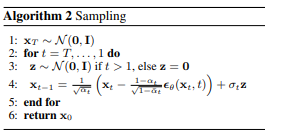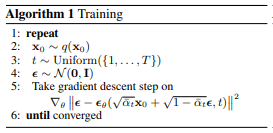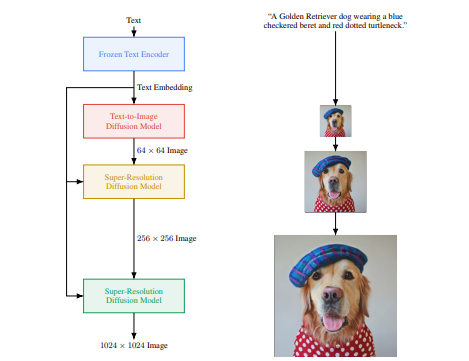Diffusers
Project description

🤗 Diffusers provides pretrained diffusion models across multiple modalities, such as vision and audio, and serves as a modular toolbox for inference and training of diffusion models.
More precisely, 🤗 Diffusers offers:
- State-of-the-art diffusion pipelines that can be run in inference with just a couple of lines of code (see src/diffusers/pipelines).
- Various noise schedulers that can be used interchangeably for the prefered speed vs. quality trade-off in inference (see src/diffusers/schedulers).
- Multiple types of models, such as UNet, that can be used as building blocks in an end-to-end diffusion system (see src/diffusers/models).
- Training examples to show how to train the most popular diffusion models (see examples).
Definitions
Models: Neural network that models p_θ(x_t-1|x_t) (see image below) and is trained end-to-end to denoise a noisy input to an image. Examples: UNet, Conditioned UNet, 3D UNet, Transformer UNet
Schedulers: Algorithm class for both inference and training. The class provides functionality to compute previous image according to alpha, beta schedule as well as predict noise for training. Examples: DDPM, DDIM, PNDM, DEIS

Diffusion Pipeline: End-to-end pipeline that includes multiple diffusion models, possible text encoders, ... Examples: GLIDE, Latent-Diffusion, Imagen, DALL-E 2
Philosophy
- Readability and clarity is prefered over highly optimized code. A strong importance is put on providing readable, intuitive and elementary code desgin. E.g., the provided schedulers are separated from the provided models and provide well-commented code that can be read alongside the original paper.
- Diffusers is modality independent and focusses on providing pretrained models and tools to build systems that generate continous outputs, e.g. vision and audio.
- Diffusion models and schedulers are provided as consise, elementary building blocks whereas diffusion pipelines are a collection of end-to-end diffusion systems that can be used out-of-the-box, should stay as close as possible to their original implementation and can include components of other library, such as text-encoders. Examples for diffusion pipelines are Glide and Latent Diffusion.
Quickstart
Installation
Note: If you want to run PyTorch on GPU on a CUDA-compatible machine, please make sure to install the corresponding torch version from the
official website.
git clone https://github.com/huggingface/diffusers.git
cd diffusers && pip install -e .
1. diffusers as a toolbox for schedulers and models.
diffusers is more modularized than transformers. The idea is that researchers and engineers can use only parts of the library easily for the own use cases.
It could become a central place for all kinds of models, schedulers, training utils and processors that one can mix and match for one's own use case.
Both models and schedulers should be load- and saveable from the Hub.
For more examples see schedulers and models
Example for DDPM:
import torch
from diffusers import UNetModel, DDPMScheduler
import PIL
import numpy as np
import tqdm
generator = torch.manual_seed(0)
torch_device = "cuda" if torch.cuda.is_available() else "cpu"
# 1. Load models
noise_scheduler = DDPMScheduler.from_config("fusing/ddpm-lsun-church", tensor_format="pt")
unet = UNetModel.from_pretrained("fusing/ddpm-lsun-church").to(torch_device)
# 2. Sample gaussian noise
image = torch.randn(
(1, unet.in_channels, unet.resolution, unet.resolution),
generator=generator,
)
image = image.to(torch_device)
# 3. Denoise
num_prediction_steps = len(noise_scheduler)
for t in tqdm.tqdm(reversed(range(num_prediction_steps)), total=num_prediction_steps):
# predict noise residual
with torch.no_grad():
residual = unet(image, t)
# predict previous mean of image x_t-1
pred_prev_image = noise_scheduler.step(residual, image, t)
# optionally sample variance
variance = 0
if t > 0:
noise = torch.randn(image.shape, generator=generator).to(image.device)
variance = noise_scheduler.get_variance(t).sqrt() * noise
# set current image to prev_image: x_t -> x_t-1
image = pred_prev_image + variance
# 5. process image to PIL
image_processed = image.cpu().permute(0, 2, 3, 1)
image_processed = (image_processed + 1.0) * 127.5
image_processed = image_processed.numpy().astype(np.uint8)
image_pil = PIL.Image.fromarray(image_processed[0])
# 6. save image
image_pil.save("test.png")
Example for DDIM:
import torch
from diffusers import UNetModel, DDIMScheduler
import PIL
import numpy as np
import tqdm
generator = torch.manual_seed(0)
torch_device = "cuda" if torch.cuda.is_available() else "cpu"
# 1. Load models
noise_scheduler = DDIMScheduler.from_config("fusing/ddpm-celeba-hq", tensor_format="pt")
unet = UNetModel.from_pretrained("fusing/ddpm-celeba-hq").to(torch_device)
# 2. Sample gaussian noise
image = torch.randn(
(1, unet.in_channels, unet.resolution, unet.resolution),
generator=generator,
)
image = image.to(torch_device)
# 3. Denoise
num_inference_steps = 50
eta = 0.0 # <- deterministic sampling
for t in tqdm.tqdm(reversed(range(num_inference_steps)), total=num_inference_steps):
# 1. predict noise residual
orig_t = noise_scheduler.get_orig_t(t, num_inference_steps)
with torch.no_grad():
residual = unet(image, orig_t)
# 2. predict previous mean of image x_t-1
pred_prev_image = noise_scheduler.step(residual, image, t, num_inference_steps, eta)
# 3. optionally sample variance
variance = 0
if eta > 0:
noise = torch.randn(image.shape, generator=generator).to(image.device)
variance = noise_scheduler.get_variance(t).sqrt() * eta * noise
# 4. set current image to prev_image: x_t -> x_t-1
image = pred_prev_image + variance
# 5. process image to PIL
image_processed = image.cpu().permute(0, 2, 3, 1)
image_processed = (image_processed + 1.0) * 127.5
image_processed = image_processed.numpy().astype(np.uint8)
image_pil = PIL.Image.fromarray(image_processed[0])
# 6. save image
image_pil.save("test.png")
2. diffusers as a collection of popula Diffusion systems (GLIDE, Dalle, ...)
For more examples see pipelines.
Example image generation with PNDM
from diffusers import PNDM, UNetModel, PNDMScheduler
import PIL.Image
import numpy as np
import torch
model_id = "fusing/ddim-celeba-hq"
model = UNetModel.from_pretrained(model_id)
scheduler = PNDMScheduler()
# load model and scheduler
ddpm = PNDM(unet=model, noise_scheduler=scheduler)
# run pipeline in inference (sample random noise and denoise)
with torch.no_grad():
image = ddpm()
# process image to PIL
image_processed = image.cpu().permute(0, 2, 3, 1)
image_processed = (image_processed + 1.0) / 2
image_processed = torch.clamp(image_processed, 0.0, 1.0)
image_processed = image_processed * 255
image_processed = image_processed.numpy().astype(np.uint8)
image_pil = PIL.Image.fromarray(image_processed[0])
# save image
image_pil.save("test.png")
Text to Image generation with Latent Diffusion
Note: To use latent diffusion install transformers from this branch.
from diffusers import DiffusionPipeline
ldm = DiffusionPipeline.from_pretrained("fusing/latent-diffusion-text2im-large")
generator = torch.manual_seed(42)
prompt = "A painting of a squirrel eating a burger"
image = ldm([prompt], generator=generator, eta=0.3, guidance_scale=6.0, num_inference_steps=50)
image_processed = image.cpu().permute(0, 2, 3, 1)
image_processed = image_processed * 255.
image_processed = image_processed.numpy().astype(np.uint8)
image_pil = PIL.Image.fromarray(image_processed[0])
# save image
image_pil.save("test.png")
Text to speech with BDDM
Follow the isnstructions here to load tacotron2 model.
import torch
from diffusers import BDDM, DiffusionPipeline
torch_device = "cuda"
# load the BDDM pipeline
bddm = DiffusionPipeline.from_pretrained("fusing/diffwave-vocoder-ljspeech")
# load tacotron2 to get the mel spectograms
tacotron2 = torch.hub.load('NVIDIA/DeepLearningExamples:torchhub', 'nvidia_tacotron2', model_math='fp16')
tacotron2 = tacotron2.to(torch_device).eval()
text = "Hello world, I missed you so much."
utils = torch.hub.load('NVIDIA/DeepLearningExamples:torchhub', 'nvidia_tts_utils')
sequences, lengths = utils.prepare_input_sequence([text])
# generate mel spectograms using text
with torch.no_grad():
mel_spec, _, _ = tacotron2.infer(sequences, lengths)
# generate the speech by passing mel spectograms to BDDM pipeline
generator = torch.manual_seed(0)
audio = bddm(mel_spec, generator, torch_device)
# save generated audio
from scipy.io.wavfile import write as wavwrite
sampling_rate = 22050
wavwrite("generated_audio.wav", sampling_rate, audio.squeeze().cpu().numpy())
TODO
- Create common API for models [ ]
- Add tests for models [ ]
- Adapt schedulers for training [ ]
- Write google colab for training [ ]
- Write docs / Think about how to structure docs [ ]
- Add tests to circle ci [ ]
- Add more vision models [ ]
- Add more speech models [ ]
- Add RL model [ ]
Project details
Release history Release notifications | RSS feed
Download files
Download the file for your platform. If you're not sure which to choose, learn more about installing packages.
Source Distribution
Built Distribution
File details
Details for the file diffusers-0.0.3.tar.gz.
File metadata
- Download URL: diffusers-0.0.3.tar.gz
- Upload date:
- Size: 80.6 kB
- Tags: Source
- Uploaded using Trusted Publishing? No
- Uploaded via: twine/4.0.0 CPython/3.9.7
File hashes
| Algorithm | Hash digest | |
|---|---|---|
| SHA256 | d647b803b5001a16ef71affbe132e9cc5b366ff2e7ced45ae1f009b9c4ddd00f |
|
| MD5 | ab121a2a162e252fc2aa6d3d0d4e45f6 |
|
| BLAKE2b-256 | 99c64131a5d0098ee5dbc02b29e91ade04692125b33b42284503b52b9ba14df0 |
File details
Details for the file diffusers-0.0.3-py3-none-any.whl.
File metadata
- Download URL: diffusers-0.0.3-py3-none-any.whl
- Upload date:
- Size: 95.5 kB
- Tags: Python 3
- Uploaded using Trusted Publishing? No
- Uploaded via: twine/4.0.0 CPython/3.9.7
File hashes
| Algorithm | Hash digest | |
|---|---|---|
| SHA256 | 28992834c392a8d83b25ee0692e21d0b3d2a07ea68625986fdc7f4b79b1a8f1d |
|
| MD5 | 2d47bab654ba31a7cda15f3475b0e032 |
|
| BLAKE2b-256 | d94103d697fc4eb16bacb2d8af6c95479018e97e7eecc512e9a7389935dab0f8 |




















